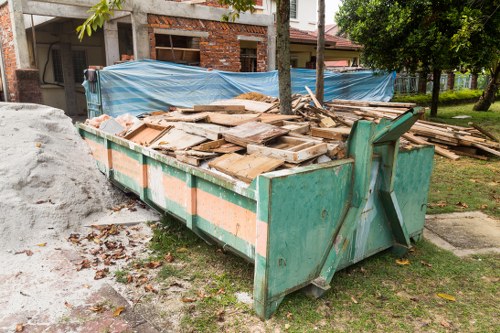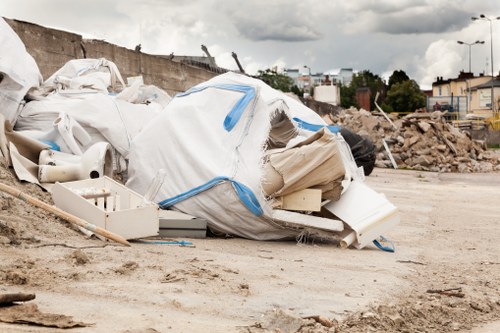Efficient Large Item Collection in Bulky Waste Management

Understanding Bulky Waste Collection
Bulky waste collection plays a critical role in maintaining clean and sustainable communities. This service focuses on the removal of oversized items that regular waste collection services cannot handle, such as furniture, appliances, and other large household or commercial items.
Effective bulky waste collection ensures that these items are disposed of responsibly, reducing the environmental impact and promoting recycling and reuse whenever possible. It addresses the challenges that come with disposing of large items, which often require special handling and transportation.
Municipalities and waste management companies offer bulky waste collection services to help residents and businesses manage their large waste items efficiently. Understanding the process, benefits, and best practices of large item collection can significantly enhance the effectiveness of waste management strategies.

Importance of Large Item Collection
The collection of large items is essential for several reasons. Firstly, it helps in keeping the environment clean by preventing the accumulation of bulky waste that can clutter streets and public spaces.
Secondly, proper disposal of large items minimizes the risk of pollution. Many bulky items contain materials that can be harmful if not handled correctly, such as electronic components in appliances or hazardous substances in furniture treatments.
Furthermore, efficient bulky waste collection promotes recycling and the circular economy. By ensuring that large items are collected and sorted appropriately, valuable materials can be recovered and reused, reducing the demand for new resources.
- Maintains public cleanliness
- Reduces environmental pollution
- Promotes recycling and resource conservation
- Enhances community aesthetics and safety

Types of Large Items Collected
Bulky waste collection services typically handle a variety of large items, each requiring specific handling procedures. Common items include:
- Furniture: sofas, mattresses, tables, and chairs
- Appliances: refrigerators, washing machines, dryers, and microwaves
- Electronics: televisions, computers, and other large electronic devices
- Construction debris: wooden planks, metal beams, and other building materials
- Garden equipment: lawnmowers, large planters, and outdoor furniture
Each type of item presents unique challenges in terms of disposal and recycling. For instance, electronics often contain hazardous materials that require specialized recycling processes, while furniture may be repurposed or refurbished to extend its useful life.
Understanding the categories of bulky waste helps in organizing efficient collection schedules and ensuring that each item is processed appropriately.

Challenges in Large Item Collection
Collecting large items poses several challenges that waste management services must address to ensure efficiency and sustainability.
One significant challenge is logistics. Transporting bulky items requires specialized vehicles and equipment, which can increase operational costs. Additionally, scheduling pickups at convenient times for residents and businesses can be complex, especially in densely populated areas.
Another challenge is the safe disposal of hazardous materials. Items like appliances often contain components that can be harmful to the environment if not handled correctly. Ensuring that these materials are disposed of responsibly is crucial for maintaining environmental standards.
- Logistical complexities in transportation
- High operational costs
- Safe disposal of hazardous materials
- Ensuring compliance with environmental regulations

Best Practices for Effective Large Item Collection
To optimize large item collection in bulky waste management, adopting best practices is essential. These practices ensure that the process is efficient, environmentally friendly, and cost-effective.
Scheduling and Planning: Proper scheduling ensures that pickups are conducted at times that are convenient for residents and businesses, reducing disruptions and improving service satisfaction.
Community Engagement: Educating the community about what can be collected and how to prepare items for pickup encourages responsible disposal and increases participation in recycling programs.
- Implementing clear guidelines for item preparation
- Providing timely and efficient pickup services
- Collaborating with recycling and refurbishment centers
- Utilizing technology for route optimization
Environmental Considerations
Ensuring that collected large items are processed in an environmentally responsible manner is paramount. This includes:
- Sorting items for recycling or reuse
- Proper disposal of hazardous materials
- Reducing landfill waste through efficient recycling programs
- Implementing sustainable transportation methods
Technological Advancements in Bulky Waste Collection
Technology plays a pivotal role in enhancing large item collection services. Innovations such as route optimization software, GPS tracking, and automated scheduling systems improve the efficiency and reliability of bulky waste collection.
Advanced sorting technologies help in accurately categorizing items for recycling or disposal, ensuring that materials are handled appropriately and reducing the environmental impact.
Additionally, online platforms and mobile applications allow residents to schedule pickups, track their requests, and receive notifications, making the process more user-friendly and accessible.
Integration with Smart Cities
As cities become smarter, bulky waste collection services integrate with other urban management systems. This integration facilitates better data sharing, real-time monitoring, and enhanced service delivery, contributing to overall urban sustainability.
Cost Management in Large Item Collection
Managing costs is a significant aspect of large item collection services. Efficient operations can lead to reduced expenses and increased service affordability for residents and businesses.
Key strategies for cost management include:
- Optimizing collection routes to reduce fuel consumption and vehicle wear
- Investing in durable and efficient equipment
- Training staff to handle items safely and efficiently
- Implementing recycling programs that generate revenue from recovered materials
By focusing on these strategies, waste management companies can maintain a balance between operational efficiency and cost-effectiveness, ensuring sustainable service delivery.
Funding and Grants
Accessing funding and grants from government programs or environmental organizations can support large item collection initiatives. These financial resources enable the adoption of new technologies, expansion of services, and implementation of eco-friendly practices.
Regulatory Compliance and Standards
Adhering to regulatory standards is crucial for large item collection services. Compliance ensures that waste management practices meet environmental guidelines and protect public health.
Regulations may cover aspects such as:
- Proper disposal methods for hazardous materials
- Transportation safety standards
- Recycling and waste reduction targets
- Reporting and documentation requirements
Staying informed about local, state, and federal regulations helps waste management companies avoid legal issues and maintain high service standards.
Environmental Impact Assessments
Conducting regular environmental impact assessments ensures that large item collection services remain sustainable and environmentally friendly. These assessments help identify areas for improvement and guide the implementation of best practices.
Community Benefits of Large Item Collection
Effective bulky waste collection services offer numerous benefits to the community. They contribute to a cleaner and safer environment, enhance the aesthetic appeal of neighborhoods, and support public health by reducing the presence of waste that can harbor pests and diseases.
Additionally, these services promote social responsibility by encouraging recycling and reuse, fostering a culture of sustainability within the community.
- Improves public health and safety
- Enhances community aesthetics
- Supports environmental sustainability
- Fosters community engagement and responsibility
Economic Advantages
Large item collection can also have positive economic impacts. By recycling materials, communities can reduce the need for new raw materials, lowering production costs and conserving natural resources. Furthermore, recycling and refurbishment activities can create job opportunities and stimulate local economies.
Future Trends in Bulky Waste Collection
The future of large item collection is likely to be shaped by advancements in technology, increasing environmental awareness, and evolving regulatory frameworks.
Emerging trends include the use of artificial intelligence and machine learning to optimize collection routes, improve sorting processes, and predict waste generation patterns. These technologies can lead to more efficient and responsive waste management systems.
Additionally, the growing emphasis on the circular economy will drive the adoption of practices that prioritize reuse and recycling, further reducing the environmental impact of bulky waste.
Innovative Recycling Methods
Innovative recycling methods, such as upcycling and material recovery facilities, will enhance the ability to process and repurpose large items more effectively. These methods not only reduce waste but also create higher-value products from recovered materials.
Conclusion
Large item collection is a vital component of bulky waste management, contributing to environmental sustainability, community well-being, and economic efficiency. By understanding the importance, challenges, and best practices of large item collection, municipalities and waste management companies can implement effective strategies that benefit both the environment and the community.
Embracing technological advancements and adhering to regulatory standards will further enhance the efficiency and impact of bulky waste collection services.
For a cleaner, safer, and more sustainable community, contact us today to learn more about our large item collection services and how we can assist you in managing bulky waste effectively.
Get Started with Your Bulky Waste Collection
Ready to manage your bulky waste efficiently? Book your service now and take the first step towards a cleaner environment. Our dedicated team is here to help you with all your large item collection needs, ensuring a hassle-free and environmentally responsible disposal process.
Don’t let bulky waste accumulate any longer. Contact us today and experience the benefits of our professional and reliable bulky waste collection services.
Join countless satisfied customers who have made the switch to our efficient and eco-friendly bulky waste management solutions. Book now and contribute to a sustainable future.